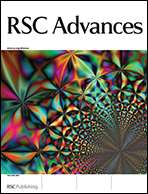Adsorption of H2S molecules by cucurbit[7]uril: an ab initio vdW-DF study
Abstract
Among the cucurbit[n]urils, much attention has been devoted to CB[7] for its intermediary cavity size as well as the significant negative charge density of carbonyl-fringed portals which assists the binding of other species. Adsorption of hydrogen sulfide by CB[7] was studied using ab initio van der Waals density functional (vdW-DF) calculations, involving a full geometry optimization. The encapsulation of up to five H2S molecules inside the cucurbit cavity, with a binding energy of about −0.10 eV per H2S, makes cucurbit[n]urils attractive as a suitable adsorption medium. Furthermore, calculations show that H2S molecules can be adsorbed on the sidewall of the CB[7] with a larger binding energy (−0.31 eV). We also address the role of vdW forces for the system under study and the obtained results revealed that the inclusion of dispersion interactions slightly affects the binding properties of the interacting molecules. In addition, the binding nature of the energetically favorable systems in ambient conditions have been investigated with ab initio MD simulations adopting the vdW-DF method. Our ab initio vdW-DF findings afford evidence for a realistic benchmark for the applicability of these novel nanostructures for H2S adsorption and elimination from various media.
![Graphical abstract: Adsorption of H2S molecules by cucurbit[7]uril: an ab initio vdW-DF study](/en/Image/Get?imageInfo.ImageType=GA&imageInfo.ImageIdentifier.ManuscriptID=C3RA41946K&imageInfo.ImageIdentifier.Year=2013)

 Please wait while we load your content...
Please wait while we load your content...